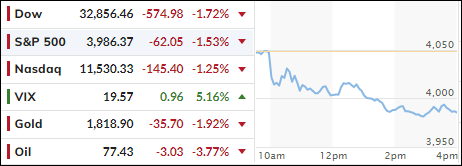
- Moving the markets
Today, it was Powell himself singing from the same hymn sheet that his mouthpieces have used for months, namely rates may need to go “higher for longer,” a theme I have pounded on ad nauseum.
Maybe today, market participants are finally buying what Powell is selling, which caused havoc in all asset classes, since there was no place to hide other than in cash. The fear now on Wall Street is that the expected 25bps interest hike at the next Fed meeting will give way to a more hawkish move of 50bps. That number had not been priced in at all, but its odds have now risen to above 60%.
Powell’s expressed his hawkish warning like this, as ZeroHedge pointed out:
…. If the totality of the data were to indicate that faster tightening is warranted, we would be prepared to increase the pace of rate hikes… The historical record cautions strongly against prematurely loosening policy. We will stay the course until the job is done.
Even though the above was nothing new, the markets were rudely awakened from their dream state of imagining “pause or pivot” soon. That type of wishful thinking was crushed for the time being, as Terminal Rate Expectations propelled to the 5.65% level.
Bond yields were mixed with the short end exploding higher, as the 10-year crossed above 4% again, but it was not able to hold that level, stalled and “only” closed up 12bps at 3.98%.
As a result, the US Dollar surged +1.21%, as higher rates make the currency more attractive, Crude Oil crashed about 4%, and Gold was clubbed for a variety of reasons, like fraud by the Perth Mint, a strong dollar and Powell’s hawkish speech. The precious metal managed to successfully defend its $1,800 level.
The markets are now facing an onslaught of economic data ranging from tomorrow’s ADP and JOLTS reports, Friday’s non-farm payrolls, and next week’s CPI, PPI and retail sales.
While the directional outcome is uncertain, the fact that more volatility is on deck will keep the ongoing tug-of-war between bulls and bear alive.
2. “Buy” Cycle Suggestions
For the current Buy cycle, which started on 12/1/2022, I suggested you reference my then current StatSheet for ETF selections. However, if you came on board later, you may want to look at the most recent version, which is published and posted every Thursday at 6:30 pm PST.
I also recommend for you to consider your risk tolerance when making your selections by dropping down more towards the middle of the M-Index rankings, should you tend to be more risk adverse. Likewise, a partial initial exposure to the markets, say 33% to start with, will reduce your risk in case of a sudden directional turnaround.
We are living in times of great uncertainty, with economic fundamentals steadily deteriorating, which will eventually affect earnings negatively and, by association, stock prices. I can see this current Buy signal to be short lived, say to the end of the year, and would not be surprised if it ends at some point in January.
In my advisor practice, we are therefore looking for limited exposure in value, some growth and dividend ETFs. Of course, gold has been a core holding for a long time.
With all investments, I recommend the use of a trailing sell stop in the range of 8-12% to limit your downside risk.
3. Trend Tracking Indexes (TTIs)
Our TTIs pulled back with the indexes but remained above their respective trend lines and therefore in bullish territory.
This is how we closed 03/07/2023:
Domestic TTI: +3.47% above its M/A (prior close +5.17%)—Buy signal effective 12/1/2022.
International TTI: +7.32% above its M/A (prior close +8.99%)—Buy signal effective 12/1/2022.
All linked charts above are courtesy of Bloomberg via ZeroHedge.
Contact Ulli